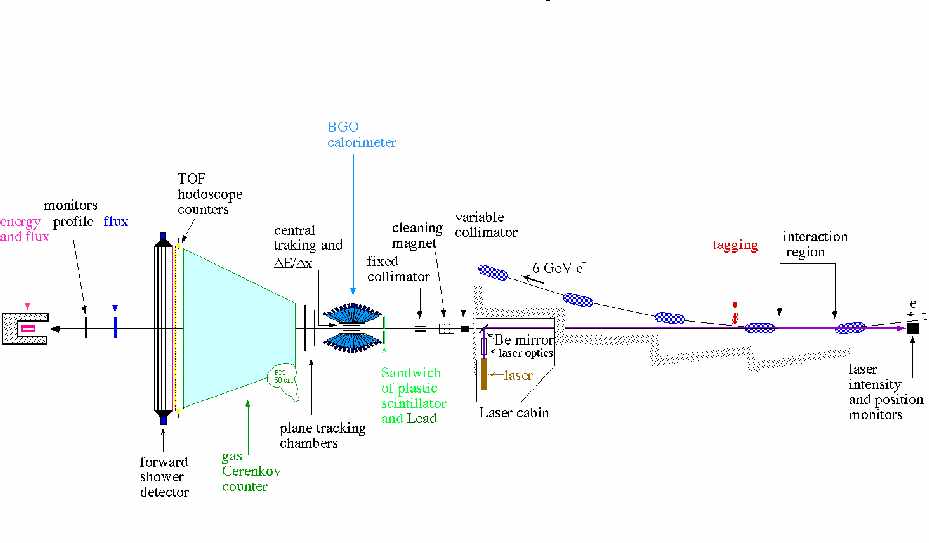Gr.A.A.L. photon beam
The high energy photon beam line of the GR.A.A.L. project is installed
at a bending magnet port with a modified front-end that allows the tagging
of the  -rays and the monitoring of the laser beam.
-rays and the monitoring of the laser beam.

The interaction region is situated in the vacuum tube of the straight
section of the storage ring between two bending magnets. Here the photons
of an 8 W argon laser of energy 3.53 eV (351.2 nm) are scattered on
the 6 GeV electrons stored in the ESRF.
The result of this backscattering is an high energy
 -ray
beam with maximum energy of 1.5 GeV.
-ray
beam with maximum energy of 1.5 GeV.

The energy spectrum of the GRAAL beam
with the UV laser light measured with the
microsptrips of the tagging counter.
The maximum intensity is:

This Compton scattering process can be
described easily because of the extremely relativistic nature of the
participating electrons. The incident laser photon beam makes an angle
 with the velocity vector of the initial electron and is scattered back with
an angle
with the velocity vector of the initial electron and is scattered back with
an angle  refered to the electron's initial direction. Two successive
Lorentz transformations (from the laboratory frame to the rest frame of the
electron and back to the laboratory frame) boost the photon energy each
time by a factor of 2
refered to the electron's initial direction. Two successive
Lorentz transformations (from the laboratory frame to the rest frame of the
electron and back to the laboratory frame) boost the photon energy each
time by a factor of 2  .
This relativistic factor
.
This relativistic factor

is so large that the angle of the scattered photon is
compressed to an extremely narrow cone ( 1 mrad) while
 looses
almost all its influence on the final
looses
almost all its influence on the final
 -ray.
-ray.
The kinematic description is also facilitated as only terms of order
1/ are retained. So to an excellent approximation the energy of the
backscattered photon is given by
are retained. So to an excellent approximation the energy of the
backscattered photon is given by

where  is the energy of the laser photon.
is the energy of the laser photon.
A maximum photon energy is produced when the laser photon is scattered
through 180 degrees ( = 0).
= 0).
One of the most interesting features of this high energy photon beam is its
polarisation that is obtained very easily: the laser produces completely
polarized photons whose polarisation is kept during the backscattering
process. For an energy near to the maximum circular or linear polarizations
of nearly 100 per cent are obtained.

degree o linear (red line) and circular (blue line) polarisation
as a funcion of the photon energy when using UV laser beam
At the exit of the bending magnet one finds the tagging region where the
distance of the trajectory of those electrons having interacted with the
photons and having lost a part of their energy, to the normal trajectory is
measured by silicon microstrips detectors providing information about
energy of the  -rays produced. An internal
tagging system
where the scattered electrons will be momentum analysed by the magnets of
the storage ring has been chosen.
-rays produced. An internal
tagging system
where the scattered electrons will be momentum analysed by the magnets of
the storage ring has been chosen.




